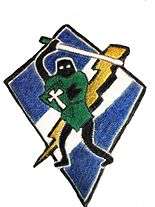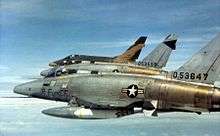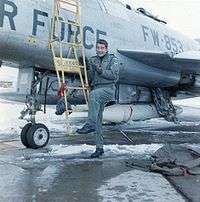481st Tactical Fighter Squadron
The 481st Tactical Fighter Training Squadron is an inactive United States Air Force fighter squadron. Its last assignment was with the 27th Tactical Fighter Wing, being stationed at Cannon AFB, New Mexico. It was inactivated on 8 July 1980.
| 481st Tactical Fighter Training Squadron | |
|---|---|
 General Dynamics F-111D 68-107 481st Tactical Fighter Training Squadron, 1979 | |
| Active | 25 Sep 1957 – 31 Aug 1973 15 Jan 1976 – 8 Jul 1980 |
| Country | United States |
| Branch | United States Air Force |
| Type | Fighter |
| Part of | Tactical Air Command 27th Fighter Wing |
| Nickname(s) | Crusaders and Green Knights[1] |
| Engagements | Battle of Ia Drang Valley |
| Decorations | |
| Commanders | |
| Notable commanders | Harold E. Comstock 1963 - 1966 |
| Insignia | |
| 481st Tactical Fighter Squadron emblem |  |
Origins
In 1957, the 27th Fighter-Escort Wing was assigned to Bergstrom Air Force Base near Austin, Texas and at that time it was part of the Strategic Air Command. In the summer of 1957, it was renamed as the 27th Tactical Fighter Wing and transferred to the Tactical Air Command.
Later in 1957, the 27th Tactical Fighter Wing was transferred on paper to Cannon Air Force Base which is just west of Clovis, New Mexico. The transfer did not involve the actual movement of any equipment or aircraft.
Constituted as the 481st Fighter Bomber Squadron on 30 August 1957 and activated 25 September 1957 at Bergstrom AFB, Texas, it remained essentially a paper unit until about January 1958 with a minimum of personnel and no aircraft assigned. On 12 December 1957, the first commander, Major Adrian E. Drew, flew a borrowed F-101 Voodoo to set a world speed record of 1,207.6 mph. Personnel and F-101 aircraft were received early in 1958 and by mid-year, the 481st was combat ready. The close of 1958 saw the recently re-designated 481st Tactical Fighter Squadron go non-operational due to all 27th Tactical Fighter Wing (TFW) F-101s being sent to the United Kingdom.[2] After the F-101 aircraft were transferred, the 312th Tactical Fighter Wing and the four squadrons of F-100 Super Sabre aircraft assigned to it had their personnel and equipment assigned to the 27th Tactical Fighter Wing. The 27th was assigned to the 832d Air Division. The four squadrons of the 312th were replaced by the 481st, 522d, 523d, and 524th Tactical Fighter Squadrons.
History
The squadron was re-activated at Cannon AFB, New Mexico, on 18 February 1959. Within five months of receiving their first F-100 aircraft, the 481st deployed to Hahn Air Base, Germany, to engage in daytime air defense operations. During this rotation, the Squadron set a Tactical Air Command (TAC) record for deploying and re-deploying without an abort or incident. During a deployment in April, 1961, the 481st sent a flight of four F-100s non-stop from Nellis Air Force Base, Nevada, to RAF Lakenheath, England. The aircraft returned to England Air Force Base, Louisiana, in time for the entire Squadron to deploy to RAF Weathersfield, England, on 9 May 1961. On 12 June 1961, the Squadron moved to Incirlik Air Base, Turkey, to fulfill its first NATO commitment. At Incirlik, the Squadron assumed an alert posture and remained until October of that year. With its parent Wing and two sister Squadrons, the 481st deployed to MacDill Air Force Base, Florida, where it maintained a constant alert posture in response to the Cuban Missile Crisis from October to December 1962.[3]
Between 1963 and 1973, aircraft and personnel from the 481st deployed many times to various parts of the world, including Europe, Iran, Saudi Arabia, Taiwan, Thailand and Japan. Some of the known deployments and history are listed below.
10 November 1963 - A deployment of 75 days to Takhli Royal Thai Air Force Base, Thailand[4]
14 November 1963 – Operation Hard Surface – A deployment to Dhahran, Saudi Arabia. This operation had started with another unit, probably from Cannon AFB, on 4 May 1963. The 481st participated in this operation from 14 November 1963 to 1 February 1964.[5]
The units assigned to this operation were awarded the Air Force Outstanding Unit Award.[6]
31 March 1964 – Exercise Delawar, a CENTO sponsored joint training exercise with the Imperial Iranian Air Force. The 481st TFS and the 429th Tactical Fighter Squadron deployed to Vahdati Air Base at Dezful Iran, with 36 aircraft and over 500 personnel.[7] [8]
7 May 1964 – Exercise Desert Strike. This was a joint Air Force and Army training exercise that took place in California, Nevada and Arizona and lasted two weeks. It involved nearly 100,000 personnel, fifteen active Air Force fighter squadrons, and numerous other flying squadrons and support units from the active military, the Air National Guard and the Air Force Reserve.[9]
28 August 1964 – The 481st TFS was selected as the outstanding fighter unit in the Tactical Air Command for the second consecutive quarter.[10]
1 September 1964 – The squadron was sent on a 120-day rotational deployment to Misawa Air Base, Japan. During this time, some aircraft of the 481st TFS also went to Kung Kuan Air Base in Taiwan. While in Taiwan, the aircraft took part in Operation Sky Soldier VI.[11]
1 June 1965 – The squadron was the first to respond and depart during a full scale no-notice Operational Readiness Inspection (ORI) conducted by an inspection team from the Tactical Air Command.[12]
From 21 June 1965 to 22 November 1965, the 481st was deployed to Tan Son Nhut Air Base, Vietnam.
Vietnam War


In the Spring of 1965, notification was received that the squadron would deploy to Vietnam in late June for a combat tour. On 11 June 1965, without prior warning, the squadron was alerted to deploy within twenty-four hours and left Cannon AFB on 12 June 1965 under the code name Operation Two Buck 16. After a one-week delay at Clark Air Force Base in the Philippines, the squadron arrived at Tan Son Nhut Airbase on 21 June 1965 and began flying combat missions on that first day in South Vietnam. [13]
On the night of 19 July, the Army Special Forces camp at Bu Dop, about 100 miles north of Saigon, came under attack by the Viet Cong. Air strikes by Capt. Norm Turner and 1st Lt. Donald Watson of the 481st were credited with "probably saving the camp that night" and both pilots were awarded the Distinguished Flying Cross for their actions. Just eleven days after this mission, one of the pilots, 1st Lt. Donald D. Watson of Tripoli, Wisconsin, was killed on 31 July while flying another air interdiction mission.
The squadron averaged over 30 sorties a days and by 6 September 1965, the 481st TFS "Crusaders" had completed 2,000 hours of combat flying.[14]
In November, many sorties were flown in support of the battle of Plei Me and airstrikes by the 481st and other fighter units were "given much of the credit for turning the battle of Plei Me from disaster into victory."[15]
When the North Vietnamese left Plei Me and Pleiku, they moved west and the 481st again supported ground troops in the battle that developed in the Ia Drang Valley. While deployed to Vietnam, the 481st aircraft had green triangles painted on the tails which allowed the Forward Air Controllers to easily identify the F-100s they were controlling as being part of the 481st. Many of the planes had personal names and pictures painted on including "The Shadow", "Lickity Split", "Pretty Penny", "Why Not?", "The Mormon Meteor", "The Back Forty", "Mr. Magoo", "Hot Stuff", "Casanova", "Snoopy", "My Little Margie" and several others.[16]
The F-100s and their assigned pilots that deployed to Vietnam are listed below: [17]
| Aircraft Tail Number | Pilot |
|---|---|
| 0-53604 | Lt. Col. Harold E. Comstock |
| 0-53613* | Capt. Charles Summers |
| 63504 | Capt. Thales "Tad" Derrick |
| 0-52837* | 1st Lt. Peter Vanderhoef |
| 63074* | Capt. William Kenty |
| 63063 | Capt. Stephen "Shad" Dvorchak |
| 63056 | Lt. Col. David Williams |
| 0-53548 | 1st Lt. Thomas Tilghman |
| 0-52795* | Capt. Norman Turner |
| 0-42177* | 1st Lt. Jimmy Kempton |
| 0-53569 | Capt. William Carrothers |
| 0-53603 | Capt. Joseph Reynes |
| 63100 | Capt. Robert Barry |
| 0-53528 | Capt. Douglas Young |
| 0-53622 | Capt. Alvord Anderson III |
| 63040 | 1st Lt. Dale Sprotberry |
| 0-53559 | Capt. Paul Phillips |
| 0-23549 | 1st Lt. Donald Watson |
* Indicates aircraft that were shot down on combat missions. A replacement aircraft, tail number 63334 was also shot down.
During the six month combat tour, the "Crusader's" F-100s received many hits but only six airplanes were lost. Captain John Parker was the first pilot to go down and the others were: Captain Joseph Reynes, Captain Charles Summers, Captain Sam Holmes, 1st Lt. Donald Watson, and 1st Lt. John Hauschildt. All ejected safely and were rescued except for 1st Lts. Watson and Hauschildt who were killed.[18]
The deaths of Lts. Watson and Hauschildt were part of a larger coincidental tragedy. When four friends who had attended the Air Force Academy together were all assigned to Cannon AFB as pilots, they decided to pool their money and buy a house. Three of the four pilots were assigned to the 481st and the fourth, Lt. Thomas McAtee, was assigned to the 429th Tactical Fighter Squadron. In the space of ten weeks, three of the four friends were killed. On 29 July 1965, Lt. Donald D. Watson was killed in South Vietnam. On 23 August 1965, Ralph Ford was killed on a training flight near Nara Visa, New Mexico and on 5 October 1965, Lt. John Hauschildt was killed on a bombing mission in South Vietnam. Lt. McAtee was in Vietnam during this time and had flown 36 combat missions with the 429th TFS. He was shocked to learn of the deaths of his three friends and returned to Clovis, New Mexico in October 1965 to sell the house.[19]


On the Vietnam Veterans Memorial Lt. Donald Davis Watson's name is on Panel 02E Row 46 and Lt. John Charles Hauschildt's name is on Panel 02E Row 107. Both men are buried at the Air Force Academy cemetery.
By 27 November 1965, the 481st was headed back to Cannon AFB and had flown more than 3,600 combat sorties and established an incredible 98% aircraft in commission rate that assured every combat mission was flown as scheduled.[20] During this deployment to Vietnam, the 481st accumulated 5,025 hours of combat flight-time.[21]
Shortly after returning to Cannon AFB, the 481st became a Replacement Training Unit charged with training F-100 pilots for worldwide assignments. The mission of the squadron did not change until 5 September 1968 when it began preparing for the receipt of F-111 aircraft and a return to tactical operations. From that date until 1 July 1969, the squadron possessed no organizational aircraft and was listed as "inactive" by the 27th TFW.[22]
F-111 era
Although 1 July 1969 saw the 481st manned again, it did not receive its first F-111E until 30 September 1969. By the close of 1969, the squadron had 24 F-111E aircraft assigned and was in training toward a status of being operationally ready when the F-111 fleet was grounded on 28 December 1969, due to the failure of a wing at Nellis AFB. During the ensuing down time, the 481st utilized a few F-100s of the 524th TFS as well as AT-33s of the 27th Combat Support Group to maintain proficiency. The 481st pilots also supported the 2nd Aircraft Delivery Group by ferrying F-100s from Europe to the U.S. and from the U.S. to Southeast Asia.
Beginning 10 May 1971, the 481st began ferrying its F-111Es to the 20th Tactical Fighter Wing at RAF Upper Heyford, England. The last aircraft left Cannon AFB on 27 July 1971 and two days later the 4427th Tactical Training Squadron absorbed all personnel and resources of the squadron. The 481st was again un-manned from 29 July 1971 until May 1972.
Although manning was increased in May 1972, the 481st was not back in business until 13 November 1972 when several 524th TFS aircrews were transferred. Squadron crews underwent extensive training at Nellis AFB and Cannon AFB, and flew the first F-111D mission on 2 March 1973. The 481st was again de-activated on 31 August 1973 with the 523rd TFS absorbing it resources.
The squadron was re-activated on 15 January 1976 as an F-111D Tactical Fighter Training Squadron. From that time until its retirement on 1 January 1980, the 481st remained the primary training squadron for F-111D aircrews.[23] [24]
Lineage
- Constituted as 481st Fighter-Bomber Squadron, on 1 July 1957
- Activated on 25 September 1957
- Re-designated: 481st Tactical Fighter Squadron, 1 July 1958
- Inactivated 18 February 1959
- Activated 18 February 1959
- Organized on 18 February 1959, assuming personnel and equipment of 477th Tactical Fighter Squadron (inactivated)
- Inactivated on 31 August 1973
- Re-designated as 481st Tactical Fighter Training Squadron, 1 January 1976
- Activated on 15 January 1976
- Inactivated on 8 July 1980
Assignments
- 27th Fighter-Bomber Wing, 25 September 1957
- 27th Tactical Fighter Wing, 1 July 1958 – 31 August 1973
- 27th Tactical Fighter Wing, 15 January 1976 – 8 July 1980
Stations
- Bergstrom AFB, Texas, 25 September 1957 – 18 February 1958
- Cannon AFB, New Mexico, 18 February 1958 – 31 August 1973
- Cannon AFB, New Mexico, 15 January 1976 – 8 July 1980
Aircraft
- F-101 Voodoo, 1958
- F-100D/F Super Sabre, 1958-1973
- General Dynamics F-111D, 1976-1980
References
- "North American F-100 Super Sabres of the 27th Tactical Fighter Wing, Cannon AFB, NM".
- "United States Air Force Fact Sheet and 481st Squadron Historian's Summary Sheet". 27th Tactical Fighter Wing and 481st TFS.
- "United States Air Force Fact Sheet and 481st Squadron Historian's Summary Sheet". 27th Tactical Fighter Wing and 481st TFS.
- "Special Order T-808". 832d Combat Support Group (TAC), Cannon Air Force Base. 5 November 1963.
- "Special Order T-808". 832d Combat Support Group (TAC), Cannon Air Force Base. 5 November 1963.
- "Special Order GB-60". 832d Combat Support Group (TAC), Cannon Air Force Base. 6 March 1964.
- "Special Order T-487". Department of the Air Force, Washington, D.C. 31 March 1964.
- "Fighters Deploying – Support To Follow". Cannon AFB newspaper, the Mach Meter. 3 April 1964.
- "First Desert Strike Men Depart". Cannon AFB newspaper, the Mach Meter. 8 May 1964.
- "TAC Selects Crusaders As Top Squadron". Cannon AFB newspaper, the Mach Meter. 28 August 1964.
- "Special Order T-1342". 832d Combat Support Group (TAC), Cannon Air Force Base. 27 August 1964.
- "Cannon Is Scene Of No-Notice ORI". Cannon AFB newspaper, the Mach Meter. 11 June 1965.
-
Thomas E. Lowe (Summer 1975). "The 481st TFS in Vietnam; A Personal Account". 20 (2). American Aviation Historical Society: 78–88. Cite journal requires
|journal=(help) -
Thomas E. Lowe (Summer 1975). "The 481st TFS in Vietnam; A Personal Account". 20 (2). American Aviation Historical Society: 82. Cite journal requires
|journal=(help) - "Jet-Seat View Of An Air Strike". U.S. News & World Report. 22 November 1965.
-
Thomas E. Lowe (Summer 1975). "The 481st TFS in Vietnam; A Personal Account". 20 (2). American Aviation Historical Society: 83. Cite journal requires
|journal=(help) -
Thomas E. Lowe (Summer 1975). "The 481st TFS in Vietnam; A Personal Account". 20 (2). American Aviation Historical Society: 88. Cite journal requires
|journal=(help) -
Thomas E. Lowe (Summer 1975). "The 481st TFS in Vietnam; A Personal Account". 20 (2). American Aviation Historical Society: 87. Cite journal requires
|journal=(help) - "Ex-CAFB Pilot Makes Sad Journey 'Home'". The Clovis News Journal. 20 October 1965.
-
Thomas E. Lowe (Summer 1975). "The 481st TFS in Vietnam; A Personal Account". 20 (2). American Aviation Historical Society: 87. Cite journal requires
|journal=(help) - "United States Air Force Fact Sheet and 481st Squadron Historian's Summary Sheet". 27th Tactical Fighter Wing and 481st TFS.
- "United States Air Force Fact Sheet and 481st Squadron Historian's Summary Sheet". 27th Tactical Fighter Wing and 481st TFS.
- "Air Force Historical Research Agency, Maxwell Air Force Base, Alabama"
- "United States Air Force Fact Sheet and 481st Squadron Historian's Summary Sheet". 27th Tactical Fighter Wing and 481st TFS.
External links
- The short film Big Picture: Exercise Delawar is available for free download at the Internet Archive